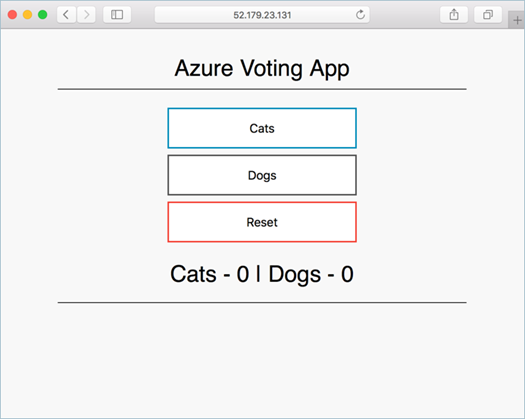In this quick start, a Kubernetes cluster is deployed using the Azure CLI. A multi-container application consisting of web front-end and a Redis instance is then deployed and run on the cluster. Once completed, the application is accessible over the internet.

This quick start assumes a basic understanding of Kubernetes concepts, for detailed information on Kubernetes see the[Kubernetes documentation][3].
If you don't have an Azure subscription, create a[free account][4]before you begin.
### Launch Azure Cloud Shell
The Azure Cloud Shell is a free Bash shell that you can run directly within the Azure portal. It has the Azure CLI preinstalled and configured to use with your account. Click theCloud Shellbutton on the menu in the upper-right of the[Azure portal][5].
The button launches an interactive shell that you can use to run all of the steps in this topic:
[][7]
If you choose to install and use the CLI locally, this quickstart requires that you are running the Azure CLI version 2.0.4 or later. Run`az --version`to find the version. If you need to install or upgrade, see[Install Azure CLI 2.0][8].
### Create a resource group
Create a resource group with the[az group create][9]command. An Azure resource group is a logical group in which Azure resources are deployed and managed.
The following example creates a resource group named_myResourceGroup_in the_eastus_location.
Azure CLICopyTry It
```
az group create --name myResourceGroup --location eastus
Create a Kubernetes cluster in Azure Container Service with the[az acs create][10]command. The following example creates a cluster named_myK8sCluster_with one Linux master node and three Linux agent nodes.
Azure CLICopyTry It
```
az acs create --orchestrator-type=kubernetes --resource-group myResourceGroup --name=myK8sCluster --generate-ssh-keys
```
After several minutes, the command completes and returns json formatted information about the cluster.
### Connect to the cluster
To manage a Kubernetes cluster, use[kubectl][11], the Kubernetes command-line client.
If you're using Azure CloudShell, kubectl is already installed. If you want to install it locally, you can use the[az acs kubernetes install-cli][12]command.
To configure kubectl to connect to your Kubernetes cluster, run the[az acs kubernetes get-credentials][13]command. This steps downloads credentials and configures the Kubernetes CLI to use them.
Azure CLICopyTry It
```
az acs kubernetes get-credentials --resource-group=myResourceGroup --name=myK8sCluster
```
To verify the connection to your cluster, use the[kubectl get][14]command to return a list of the cluster nodes.
A Kubernetes manifest file defines a desired state for the cluster, including things like what container images should be running. For this example, a manifest is used to create all object needed to run the Azure Vote application.
Create a file named`azure-vote.yaml`and copy into it the following YAML.
yamlCopy
```
apiVersion: apps/v1beta1
kind: Deployment
metadata:
name: azure-vote-back
spec:
replicas: 1
template:
metadata:
labels:
app: azure-vote-back
spec:
containers:
- name: azure-vote-back
image: redis
ports:
- containerPort: 6379
name: redis
---
apiVersion: v1
kind: Service
metadata:
name: azure-vote-back
spec:
ports:
- port: 6379
selector:
app: azure-vote-back
---
apiVersion: apps/v1beta1
kind: Deployment
metadata:
name: azure-vote-front
spec:
replicas: 1
template:
metadata:
labels:
app: azure-vote-front
spec:
containers:
- name: azure-vote-front
image: microsoft/azure-vote-front:redis-v1
ports:
- containerPort: 80
env:
- name: REDIS
value: "azure-vote-back"
---
apiVersion: v1
kind: Service
metadata:
name: azure-vote-front
spec:
type: LoadBalancer
ports:
- port: 80
selector:
app: azure-vote-front
```
Use the[kubectl create][15]command to run the application.
Azure CLICopyTry It
```
kubectl create -f azure-vote.yaml
```
Output:
bashCopy
```
deployment "azure-vote-back" created
service "azure-vote-back" created
deployment "azure-vote-front" created
service "azure-vote-front" created
```
### Test the application
As the application is run, a[Kubernetes service][16]is created that exposes the application front-end to the internet. This process can take a few minutes to complete.
To monitor progress, use the[kubectl get service][17]command with the`--watch`argument.
Azure CLICopyTry It
```
kubectl get service azure-vote-front --watch
```
Initially theEXTERNAL-IPfor the_azure-vote-front_service appears as_pending_ . Once the EXTERNAL-IP address has changed from_pending_to an_IP address_ , use`CTRL-C`to stop the kubectl watch process.
You can now browse to the external IP address to see the Azure Vote App.

### Delete cluster
When the cluster is no longer needed, you can use the[az group delete][18]command to remove the resource group, container service, and all related resources.
Azure CLICopyTry It
```
az group delete --name myResourceGroup --yes --no-wait
```
### Get the code
In this quick start, pre-created container images have been used to create a Kubernetes deployment. The related application code, Dockerfile, and Kubernetes manifest file are available on GitHub.+